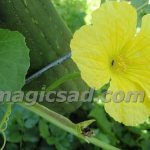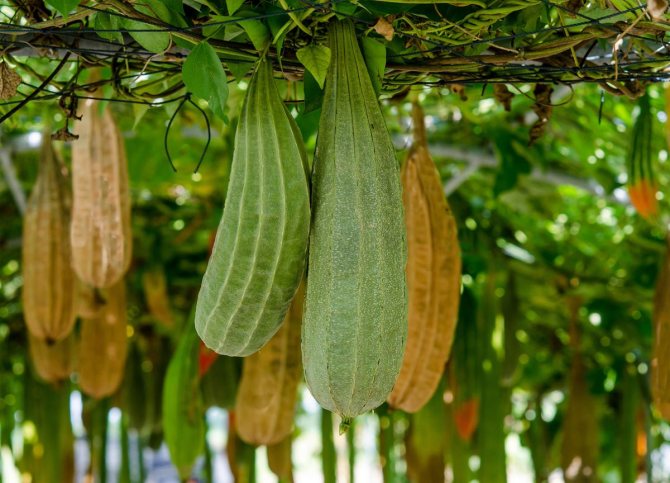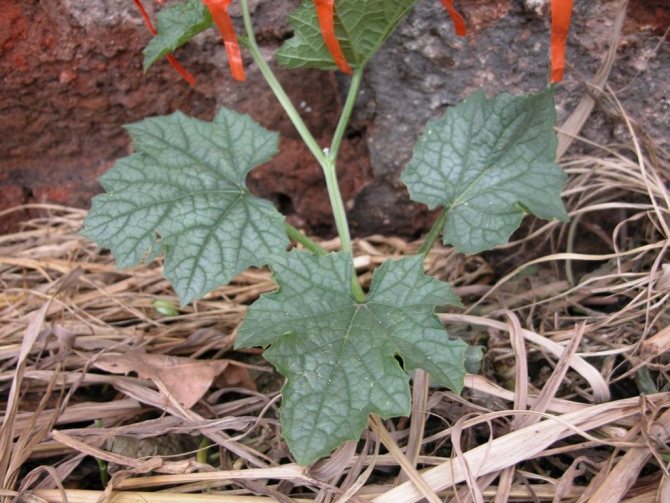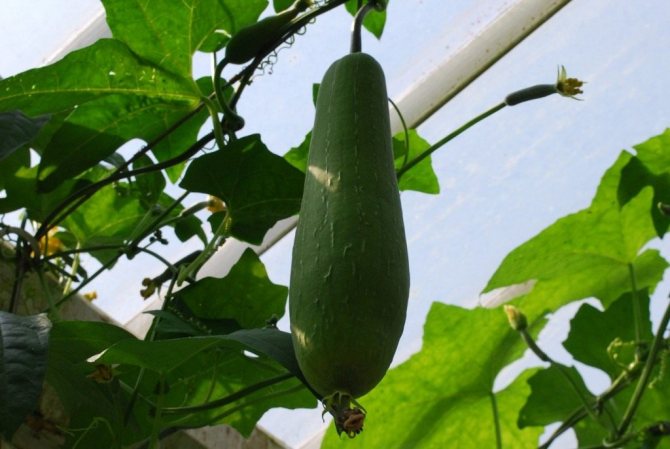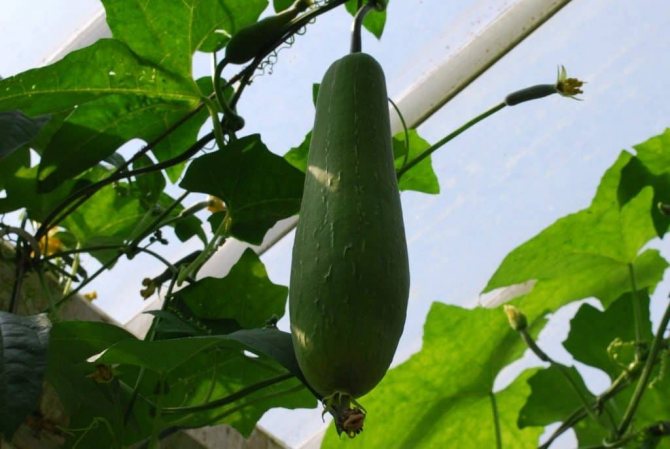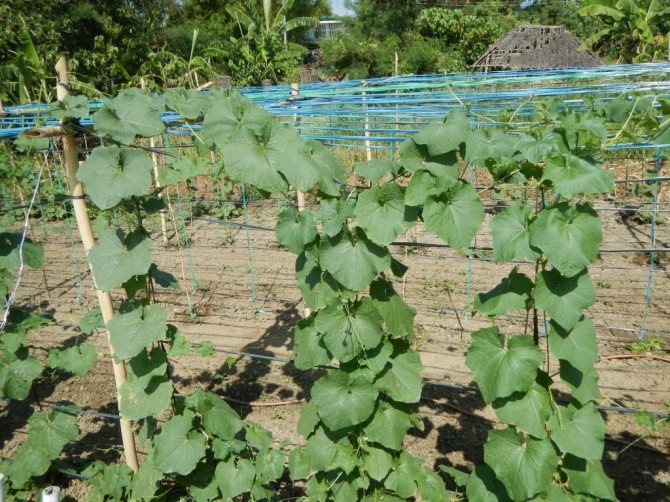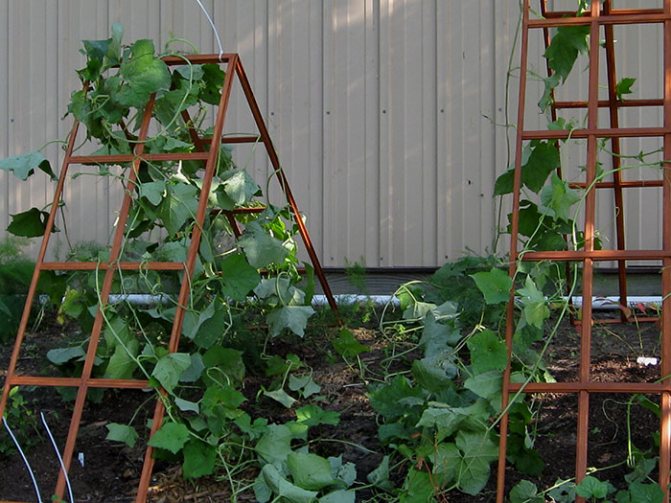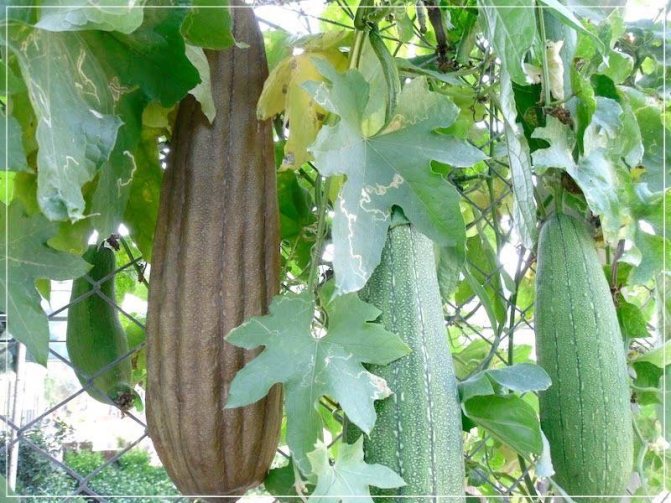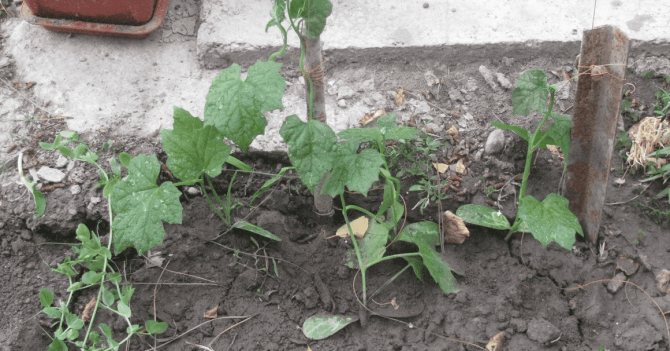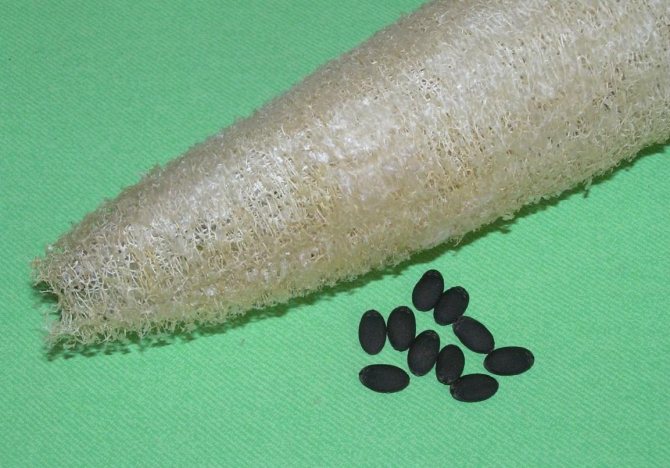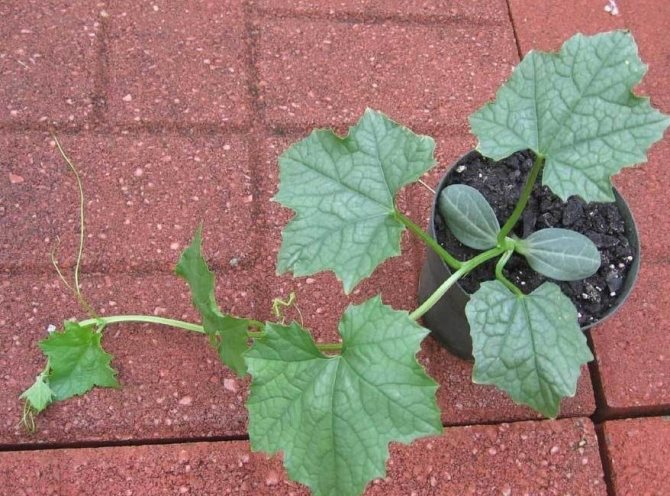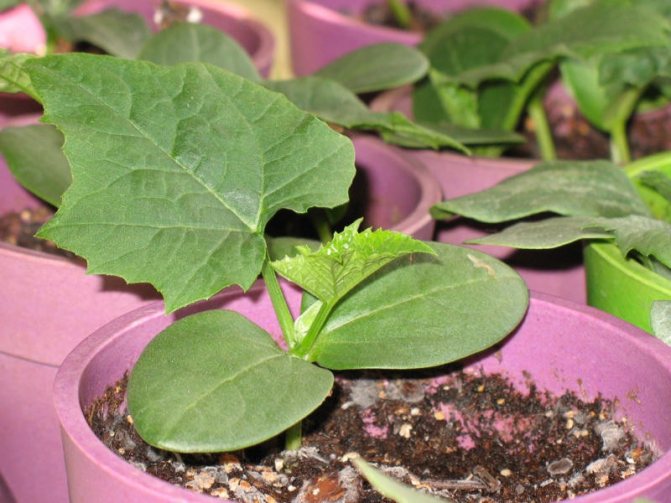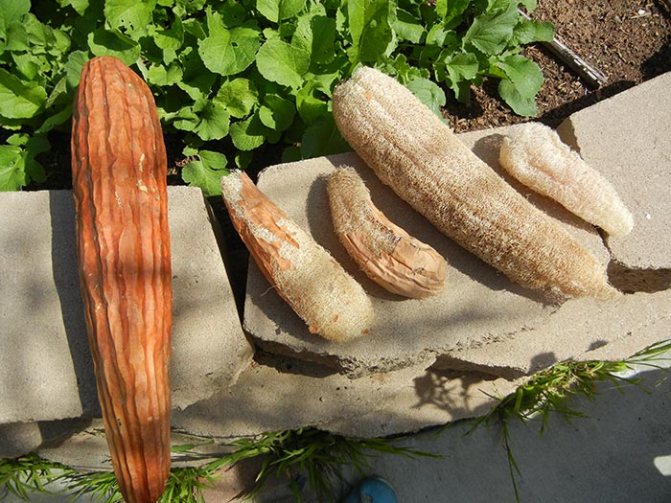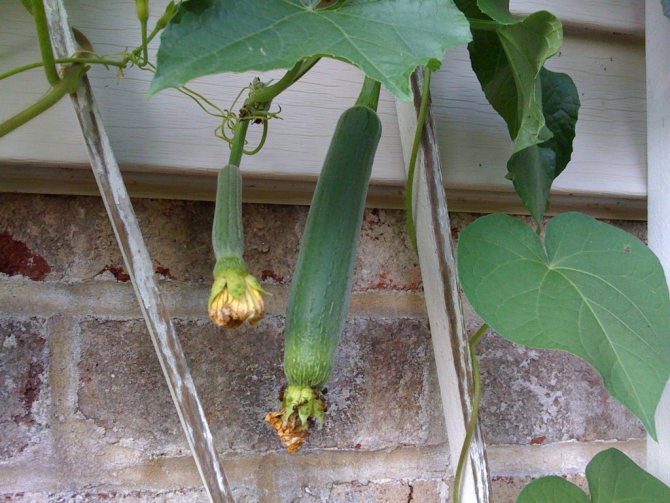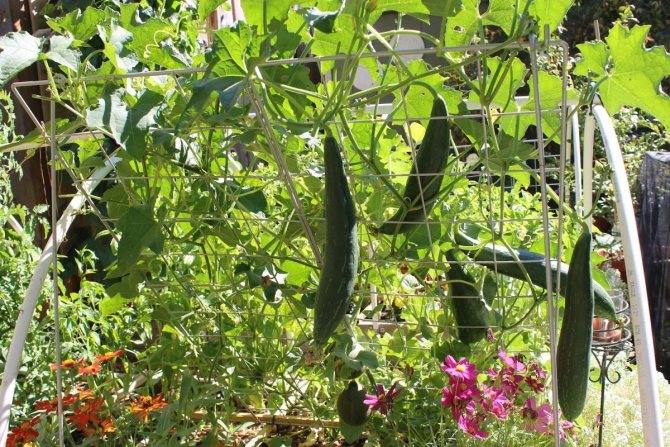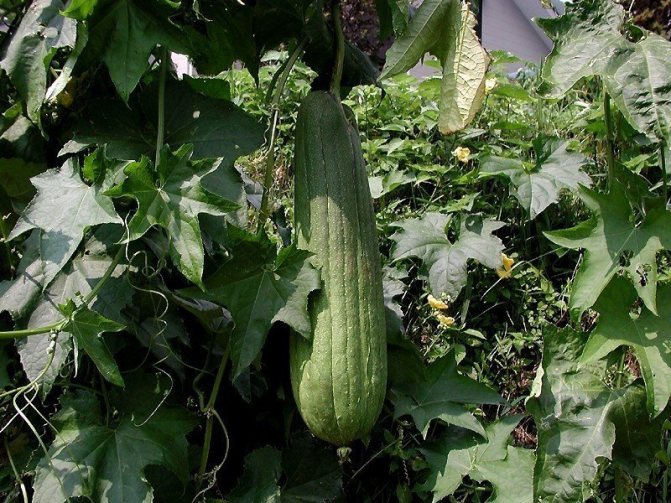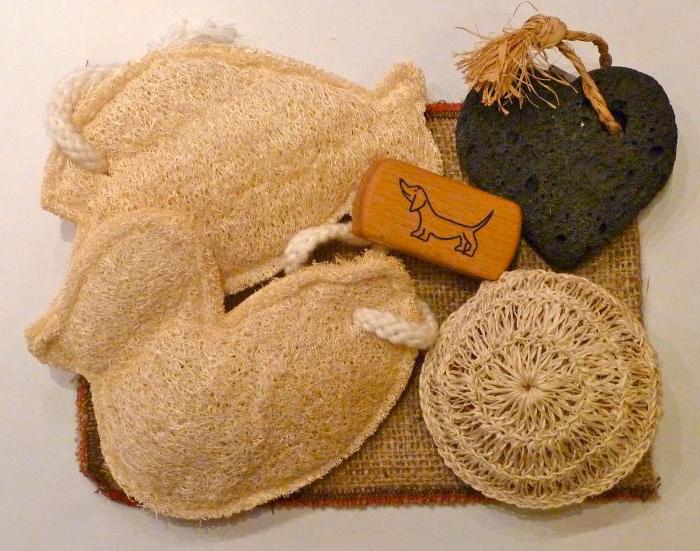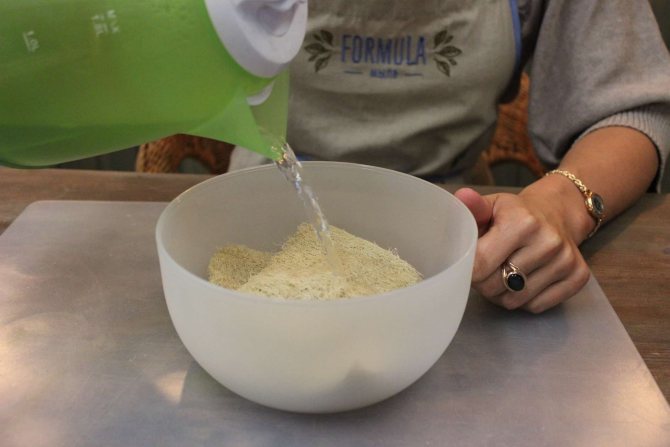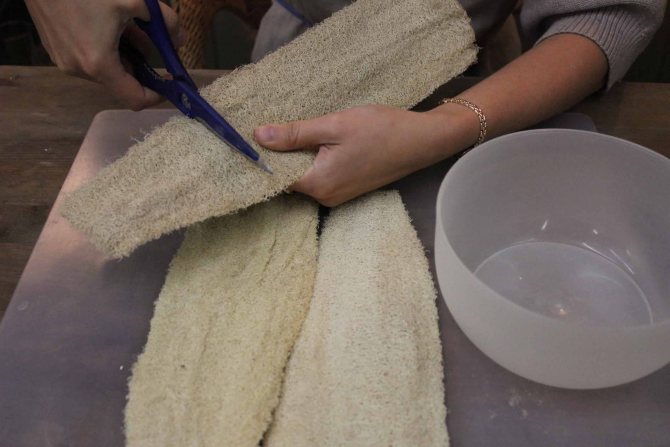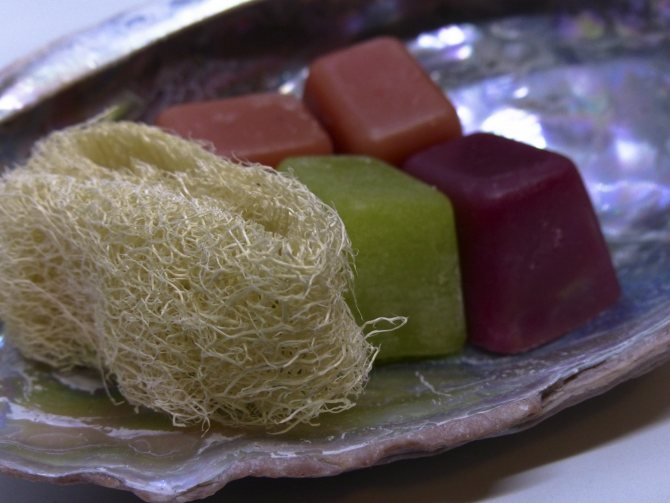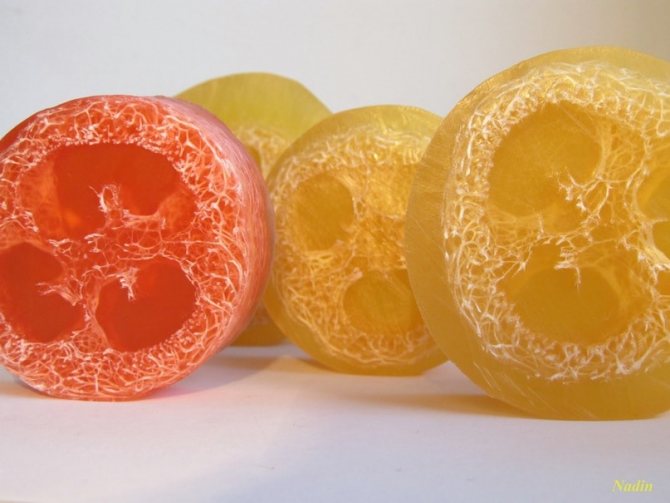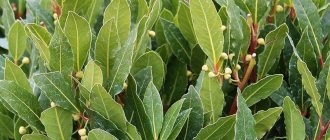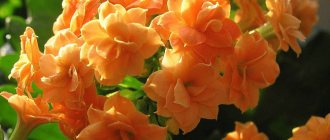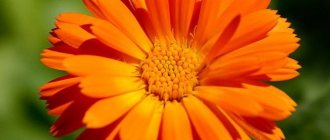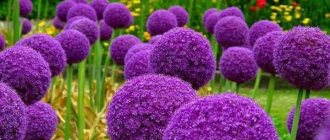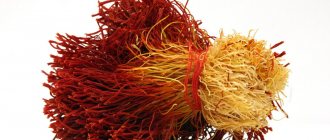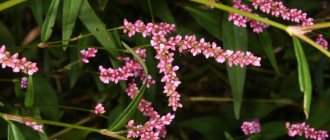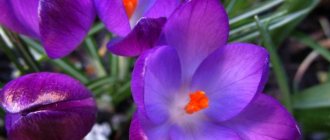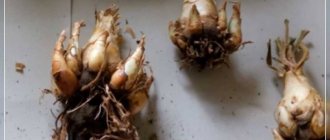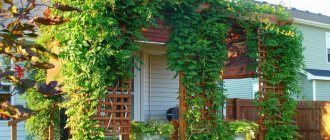Loofah is a liana from the pumpkin family that came to us from the tropics (about another native of the tropics - trichozante, read the article at the link). It is widespread in Africa, India, Central Asia and the Caucasus.
The fruit of the plant is a "squash" that conquers heights.
Luffa - growing from seeds at home
Share this article with your friends:
How to grow luffa and can you make washcloths out of it?
Luffa is a herbaceous vine of the pumpkin family. It is considered not so much a garden plant as a technical plant: washcloths are made from the ripe fruits of this plant.
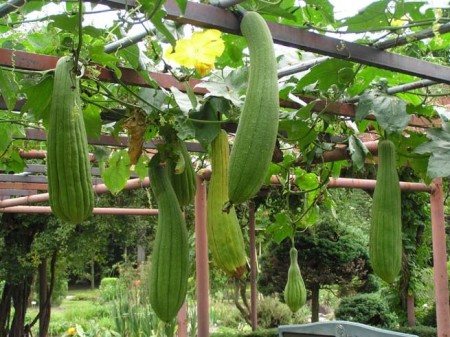
Despite its tropical origin, luffa is also grown in our climate. More often in a seedling way, since the plant has a long growing season.
Growing Luffa
Luffa is not planted in beds: for the needs of one family or landscaping a plot, it is enough to grow one or two plants. Seeds sown in cups, peat pots filled with a mixture of high peat, leafy soil and sand are guaranteed to germinate, and in open ground they may not wake up, responding to changes in weather, temperature and soil moisture.
Sowing seeds for seedlings
Do not try to sow seeds for seedlings early: a rapidly growing vine in a pot suffers from nutritional deficiencies, and after transplanting into open ground, it adapts to new conditions worse than small seedlings.
30-day-old seedlings of luffa are planted in open ground at about the same time as the seedlings of cucumbers, therefore, seeds are sown in cups in the first or second decade of April. A week before sowing, the seeds are warmed up in the sun, treated in a solution of a growth regulator (epin-extra, zircon) or soaked in aloe juice for half an hour.
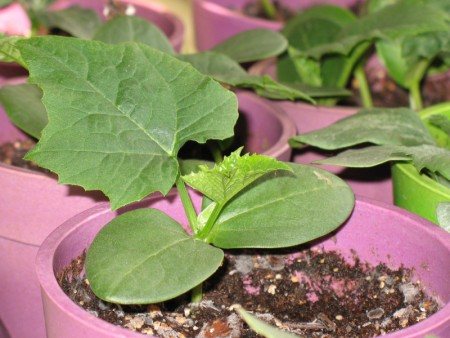

The seeds are sealed one at a time in moist soil to a depth of two centimeters, the cups are covered with plastic wrap and placed in a very warm place (plus 30 degrees). Luffa's seeds are quite large, but you shouldn't expect 100% germination from them. The seedlings that appear a week later are reduced to a temperature of plus 20 degrees.
Landing in the ground and caring for the garden moydodyr
In open ground, hardened seedlings are planted in May, when even at night the temperature does not drop below plus 15 degrees. If there are several plants, they are planted a meter apart.
A support (trellis) is immediately built, on which the vine will be fixed with antennae. Despite this, it is advisable to tie the main stem to a support in several places. A place for growing luffa is chosen well-lit, protected from the winds.
For digging, bring up a bucket of humus, 2-2.5 tbsp. tablespoons of superphosphate, according to Art. spoon of potassium sulfate and urea. A hole is dug under each plant about the depth and width of a shovel's bayonet. If the soil is heavy or sandy, humus and compost are added to the hole and mixed with the soil. Seedlings are carefully removed from the cups and planted, deepening to the cotyledon leaves.
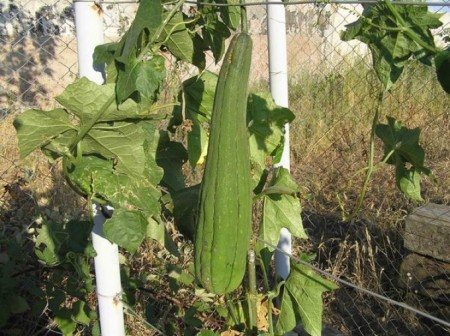

During the period of active growth, the luffa is fed twice with nitrogen fertilizers (1-2 teaspoons of urea per 10 liters of water). The plant will not have rich greenery, if every two weeks the vine is not fed with organic infusions: mullein (1:10), infusion of green grass.
Feeding with ash infusion will not hurt: a glass of 10 liters of water. Luffa is also fed with complex fertilizers for pumpkin crops.
The root system of the vine is superficial, rather weak: without regular watering, it can provide the plant with nutrition and moisture, except in a tropical climate. We have to water it often (and only with warm water), and also spray it in order to at least briefly create the effect of humid tropical air.
In the middle of summer, watered twice a week. In the fall, water less often to speed up the ripening of the fruits.
Luffa blooms in the middle of summer. First, single female flowers bloom, then "bouquets" of larger male flowers. From the female flowers, washcloth fruits will grow.
They will be even and large if, firstly, you regularly tie the lashes to the trellis so that the fruits hang freely from them and do not deform, and secondly, remove part of the ovaries so that the remaining 5-8 fruits get more nutrition.
Lateral shoots are also removed, and the main shoot is pinched when it reaches 3-4 meters. The fruits are removed before the first frost.
Making a loofah loofah
Washcloths are grown mainly from cylindrical luffa fruits. Lianas of this species grow fruits 60-70 cm long and weighing up to three kilograms. True, as it ripens, losing moisture, the fruits quickly lose weight.
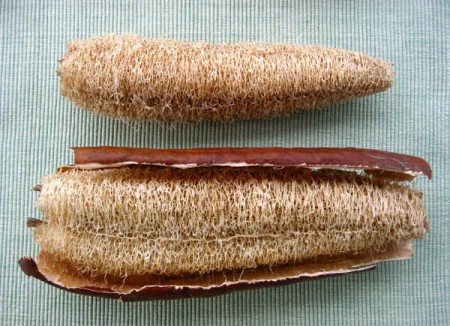

From ripe fruits, the thin skin is easily peeled off, exposing the spongy "insides". Hard washcloths are obtained from fully ripe fruits, and tender and soft ones from slightly unripe fruits.
But the young fruits of the sharp-ribbed luffa are even used for food. They are added to soups, stews, salads, stewed, fried, seasoned with garlic. In oriental medicine, loofah porridge and rice are used to treat coughs. Soups, salads are offered to patients in order to bring down the heat. Helps loofah and digestion problems.
How to make a loofah: shake the luffa fruit: if the seeds rustle in it, it is ready for processing. Cut off the ends, add the seeds and dip the loofah in boiling water for ten to twenty minutes. After the hot procedure, the fetus easily “undresses”. Wash the resulting "blanks" several times in soapy water, rinse and dry in a ventilated area. After that, you can sew ribbons to them. And the sponge from the garden is ready.
Indoor tangerine - reproduction
Before planting mandarin seeds, they are wrapped in slightly damp gauze or napkin for several days. Keep the fabric moist at all times as the seeds swell. Instead of gauze or cloth, you can use hydrogel, an excellent moisture retention agent. Seeds from a freshly eaten tangerine should be sown into the ground immediately, without being soaked.
Even if you grow only one tree, soak at least a dozen seeds: firstly, not all of them may germinate, and secondly, some seeds may die from diseases during growth, and some seedlings will not survive transplantation.
As soon as the seeds are baked, they are planted in 200 ml cups or in bowls no more than 9 cm deep with drainage holes filled with a substrate from turf soil (3 parts), humus, sand and leafy soil (1 part each) with the addition of a couple of handfuls of clay ... You will have to prepare the substrate yourself, since any of the purchased soils includes peat, which is contraindicated for tangerine.
In extreme cases, you can use the soil Biohumus or Rose as a substrate, the pH of which is in the range of 6.5-7.0 units. At the bottom of the cups, under the substrate, you need to place a layer of expanded clay or small pebbles. The seeds are buried in moist soil by 4 cm. The crops are kept at a temperature of 20-25 ºC. Seedlings emerge within three to four weeks, although this may happen earlier.
If you sowed seeds in a common container, then at the stage of formation of four leaves in seedlings (citrus fruits do not have cotyledon leaves), you need to split them into separate cups.Sometimes two plants can grow from one seed, since multi-embryonic seeds for citrus crops are quite common.
We suggest you familiarize yourself: How to grow a poppy at home
The next transplant of seedlings is carried out when their roots fill the entire volume of the cup. A small pot can be used as a container. Planting a tangerine in a pot is carried out by transferring a seedling along with an earthen lump.
How to propagate tangerine seeds, we have described in detail for you. There are other ways of plant propagation - vegetative. Unfortunately, mandarin cuttings are very difficult to root, so here are two other ways to propagate this citrus crop.
Air rooting allows you to get a new plant in the form of an already large tree, which can bloom next year. Shoot rooting is carried out directly on the mother plant. In the spring, select a three-to-four-year-old branch on the crown with well-developed shoots growing in all directions, make a 1 cm wide circular cut of bark on it 15-20 cm below the last branch and put a pot of soft plastic cut on one side with a drainage hole on the branch exactly the same size as the branch diameter.
Sew the cut side with wire and fill the pot: put moss, small shavings or sawdust on the bottom, then sand, and then wet sod-leaf humus with sand (3: 1). From the moment of swelling on the branch of the buds, 50 ml of a five percent solution of ammonium nitrate should be poured into the pot every day.
Instead of a pot, you can use a plastic bag filled with a moist substrate of the described composition, which is impregnated with a 1% solution of Heteroauxin. The bag with the substrate is put on the branch at the cut point, and the bag is tied up above and below this place.
After about six months, the branch is separated from the tangerine: it is pruned under the bag or under the pot, and when the plastic is removed, there is still a part of the shoot that needs to be cut right under the new root system. After that, the sapling tree is planted in a pot with drainage and nutritious soil and for the first time is protected from the sun with white paper.
Select a smooth place on the rootstock 5-10 cm from the ground without thorns and buds and carefully make a shallow T-shaped incision on it (the transverse one is about 1 cm long, and the longitudinal one is 2-3 cm), slightly pry the edges of the longitudinal incision and turn it off slightly bark: in this place you have to place the eye of the scion cuttings.
Now cut off a peephole from a varietal scion (a bud with a petiole sticking out of it), grabbing with a sharp knife not only the bark, but also a thin layer of wood - the shield. Above the peephole, there should be 1 cm of bark, and below - 1.5 cm.Take the cut peephole by the petiole and insert it into the T-shaped cut of the rootstock, as in a pocket, inserting the shield from top to bottom, then bandage the vaccination site from bottom to top with PVC or polyethylene tape.
You can graft two eyes on one stock on different sides of the stem.
Loofah - the new culture of our gardens
Exotic pumpkin loofah continues its triumphant march across the vastness of our Motherland. Salads are prepared from the young fruits of this plant, they are fried, baked, added to stews (and, perhaps, they will be tastier than zucchini), and fashionable organic washcloths are made from mature loofah.
Loofah is also good as an ornamental plant - it blooms all summer with large lemon-yellow "gramophones", and long fruits hang from vines along a trellis, like in a tropical jungle. Loofah has long been grown not only in greenhouses - for example, FORUMHOUSE participants receive full-fledged harvests of this crop even in Omsk.
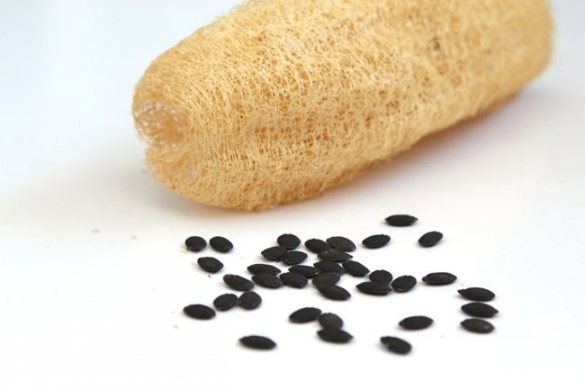

Loofah seeds resemble watermelon seeds - black, with a thick shell-armor.The main difficulty in growing a crop is to make the seed "hatch", especially old seeds are stubborn. They are soaked for a day, and then kept between wet wipes or cotton pads, while it is important to ensure the temperature is 25 degrees - the seed should be warm all the time.
Sprouted loofah seeds are sown in seedling cups at the same time as tomatoes and eggplants: a pumpkin will take at least two months to harvest.
Seedlings are planted in the sunniest, warmest place on the site. When the vines grow up to three meters, they are pinched to stimulate the side shoots.
The fruits are so delicious that they are eaten almost immediately. One or two pumpkins survive to the state of a washcloth. Young loofah is fried with garlic and herbs, stewed, pancakes are made from it - in general, they are prepared in the same way as marrow. But loofah tastes completely different.
When the luffa fruits grow to 6-7 centimeters in diameter, they begin to form a spongy skeleton. From this time on, the fruits are no longer suitable for food. When the pumpkin darkens, turns brownish, and the shoots dry up and die off, it is ready to become a washcloth.
Making a loofah is simple: just rinse the inside of the ripe loofah and remove the seeds. After that, the sponge is dried for several days under a roof, in a well-ventilated area. The dry sponge is cut into several pieces.
Six useful facts about loofah:
In our climate, two varieties have proven themselves well: Luffa acutangula and Luffa cylindrica. Cylindrical is grown specifically for the production of loofahs, but both of these varieties are edible.
Sharp-ribbed loofah (Luffa acutangula)
Grown for the sake of young unripe fruits, which are used for food. This variety is represented by an annual liana, reaching a length of 3-6 meters. The pentahedral stems have rough edges on the ribs and are fixed to the support using branched antennae.
The leaf plates reach 20 cm in diameter, in most cases they are 5-7-angular or divided into several separate lobes. The attachment of the leaves to the stem is carried out by means of rather long petioles - about 8-12 cm each. All the flowers of the plant are heterosexual and can have five 2-cm petals of a pale yellow color.
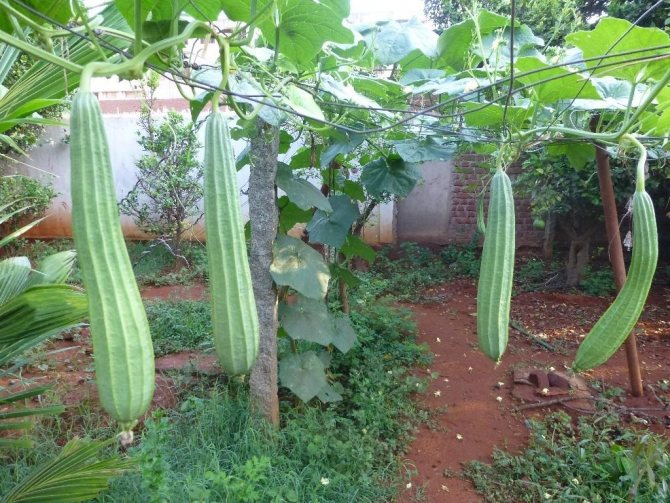

Sharp-ribbed loofah (Luffa acutangula).
Staminate species form racemose inflorescences, 17-20 in each, and pistillate ones are solitary and are located in the axils of the same leaves as staminate ones. The fruits of the sharp-ribbed loofah are club-shaped and reach half a meter in length, with a diameter of 6-10 cm.
On a note! Flowers bloom only at night, so they are pollinated exclusively by nocturnal insects. The growing season at l. sharp ribbed rather short, and the species itself is undemanding to the climate and soil, practically not susceptible to fungal diseases.
The taste of young specimens resembles cucumber, except that the pulp is sweeter. As soon as the fruits are completely dry, they are no longer suitable for food, but a fibrous sponge, created by woven conductive bundles, remains under the peel. The seeds inside are egg-shaped and reach a centimeter in length. In ripe fruits, they are yellowish-black or completely black.


The green corrugated fruit dries completely after flowering and ripening.
Ripe fruits are unsuitable for eating, as they give off strong bitterness. In cooking, the rest of the plant is also often used: buds, leaves, shoots and even flowers, and all that is needed to get a tasty side dish is simply to extinguish them or season with oil.
Sowing seeds for seedlings
Botanists classify Luffa to the genus of herbaceous vines. In the native tropics of Asia, it develops up to five meters in height, and in temperate climatic latitudes, plant growth is more restrained.However, it is characterized by a long growing season.
Therefore, agronomists advise giving preference to the seedling method when growing an exotic crop. In this way, early bountiful harvests become a reality.


Optimal timing for sowing
For early fruit, given the thick, hard skin on the seeds, germination of the loofah should be started in mid-winter. Already in the first week of February, you can prepare seeds for sowing, and as soon as small sprouts hatch from them, you immediately need to plant.
On average, this period lasts no more than two weeks. But some owners of the "growing sponge" share their experience of sowing seeds in April. True, in this version, the harvest will be much later. In any case, plan all work with reference to the lunar calendar.
Containers and soil for planting
The Asian heat-loving guest stands out from the pumpkin family for soil and planting requirements. It turns out that the culture does not like transplants very much, prefers only fertile and loose soil.
Experts advise germinating a whimsical plant in plastic cups. But when choosing them, you should take into account the volumes of future seedlings, it is advisable to use containers with a diameter of up to 7 cm.
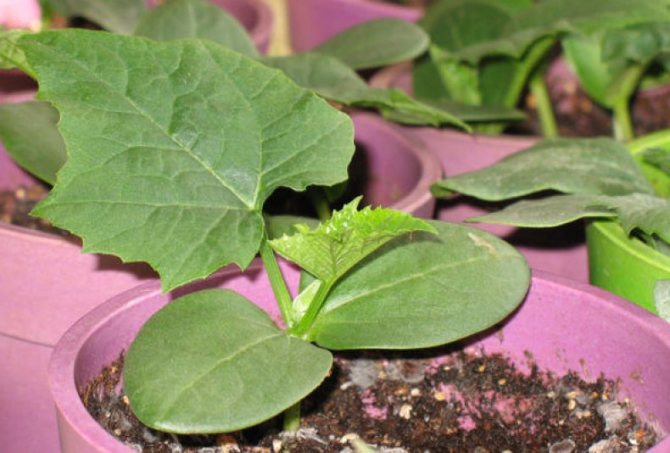

It consists in using purchased peat tablets or pots. For the luffa, such a cultivation technique will provide the necessary nutrition until the seedlings are transplanted to a permanent place, moreover, the sprouts and roots are not injured during work.
Preliminary preparation of seeds
In order for a washcloth to grow from a loofah, the seeds must be carefully prepared for sowing. After all, finding themselves in an unfavorable environment, they may not germinate at all. First of all, agronomists advise to soak the seed for several days.
To do this, use a weak solution of potassium permanganate, aloe juice or ordinary warm water with a growth stimulator. As the last ingredient, Emistim, Kornevin, Ecosil and other preparations are suitable.


For soaking, the seeds are placed in gauze or cotton cloth and tied in a knot. Then it is dipped into the prepared warm liquid and left near a battery or other heating device. After 7-14 days, the seeds will hatch.
Sowing seeds
When to plant a loofah for seedlings, it will determine the period of seed hatching. Once they are ready, you can start sowing. If you purchased peat tablets for these purposes, they will need to be thoroughly moistened before they swell completely.
Then sow the seeds to a depth of 2 cm. On top of the pill cup is covered with an identical container to create a greenhouse effect.
If you plan to fill the container with self-prepared soil mixture, planting is done in the same way as in the previous version. At the end of the work, be sure to cover the pot with a film or a transparent plastic lid.
Conditions for germination
It is advisable to place the "greenhouse" on the southern windowsill, where it is always warm and full of light. Keep away from drafts and open vents. Under favorable conditions, seedlings should appear in 3-4 days.
Seedling care
Luffa in planting and care bears a resemblance to cucumbers. Pumpkin exotic also needs moisture for its further development. But the main thing is not to overdo it.
Watering young seedlings is necessary only when the top layer of the substrate in the glass dries up. In no case, do not bring it to the state of swamp slurry.
The temperature in the room where the loofah grows should be at least 20 degrees. Liana grows quickly and is cultivated indoors until approximately May.


Hardening of seedlings
The grown shoots must be hardened, otherwise they may die in more severe conditions. The first hardening is desirable on a sunny warm day after 4 pm. During this period, the outside air will warm up enough, and the plant will not receive stress.
It is advisable to take the plant outside every day. If you plan to plant a luffa in the country, and you grow seedlings in a city apartment, put the pots on an open balcony or windows. In the open air, seedlings can eventually be left for 5-6 hours. Only this should be done gradually.
general characteristics
Few of the inhabitants of the northern latitudes are familiar with this amazing vine. Luffa is native to West Africa and Northwest India. In nature, you can find about 50 varieties of this plant. Like most tropical species, it can be successfully grown in the middle and even in the northern regions of Russia. To do this, it is enough to get acquainted with the landing and care techniques and, of course, try to follow everything carefully.
Morphological description


Luffa washcloth is a herbaceous annual liana, the closest relative of our zucchini and cucumbers. The length of the whip-like stems with antennae can reach 6 meters. The leaves are large (about 20 cm), finger-like, sometimes there are vines with a solid edge of the leaf plate. The plant is dioecious, both pistillate (female) and staminate (male) flowers develop on each specimen. Pistillate flowers are located singly, and staminate ones are collected in small inflorescences-brushes. The flowers are rather large, often yellow, and are similar in shape to cucumber and pumpkin flowers.
In place of the female flower, an elongated fruit is formed, reaching 70 cm in length. An unripe fruit has a delicate white flesh under the skin. In a mature state, it acquires a reticular fibrous structure, in the middle part of which oblong large seeds (about 1.5 cm) of black color ripen.
The root system is poorly developed and is located in the upper layers of the soil.
Properties and use
The use of various parts of the washcloth plant is based on the characteristics of its chemical composition and physical properties. Luffa has a wide range of uses, from cooking to military uniforms:
- The content of carotene in the leaves of the plant is one and a half times higher than that of carrots or pepper. Young fruits taste great and are cooked in the same way as zucchini and eaten raw. In addition, they are included in recipes for making various soups, salads, curry sauce. As a side dish, lightly extinguished and seasoned with oil, other parts of the luffa are also used: buds, flowers, leaves and shoots.
- The green parts of luffa are rich in iron and vitamin C. The Japanese use luffa juice to make expensive lipsticks and cleansing lotions.
- The seeds contain about 40% protein and 45% edible oil. Luffa oil is used in cosmetology, it is included in various creams, masks and other products.
- The fibrous and porous structure of overripe fruits provides good sound insulation and filtration qualities. In the 20th century, the US Army used them in the manufacture of steel soldier helmets and armored vehicle bodies, as well as fuel filters for engines.
- From the ripe fruits of the luffa, people have long learned to make washcloths. Such a natural helper has serious advantages over synthetic counterparts. It perfectly cleanses and massages the skin, has an anti-cellulite effect and improves blood circulation.
- The luffa plant has also found application in folk medicine. Fruit porridge with rice helps to cleanse the lungs and get rid of a lingering cough. The high fiber content helps the intestines and is useful for bloating and flatulence. Luffa dishes have antipyretic effects and stimulate lactation. Homeopathic medicine uses the plant for rhinitis and various types of allergies. Decoctions of roots and stems have a hemostatic effect and are used for internal bleeding. Luffa juice is used in the treatment of conjunctivitis and anemia.
Home care for ficus Benedict Ali
Planting seedlings in open ground
The thermophilic garden "moidodyr" is very sensitive to changes in soil, climate and care.Let's analyze the main mistakes of summer residents and figure out how to plant a loofah correctly.
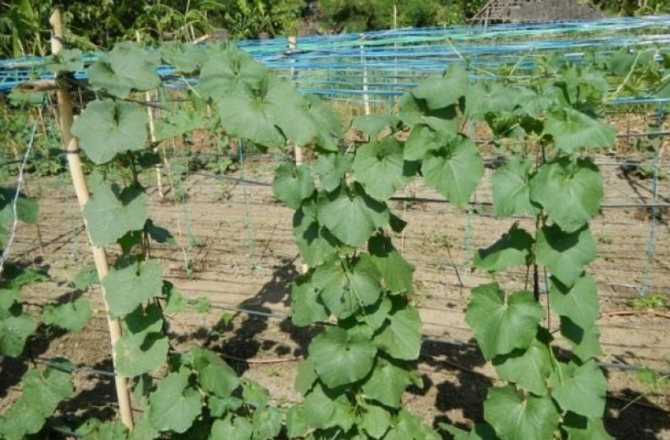

Optimal timing for planting
When the fifth leaf develops on the liana, it is time to transplant seedlings into open ground. At the same time, it is important to take into account the daytime temperature outside, since the tropical culture is not at all adapted to the cold.
It is desirable that the thermometer rises above 15 ° C, and stable warm weather is established in the yard. In total, plan a transplant no earlier than May.
Choosing a place for growing
You should take a closer look at the site for planting luffa in advance, even when the seedlings are content with the heat on your windowsill. And all because there is a complex of preparatory work ahead of transplantation.
Only a well-lit area protected from northern winds and drafts can please a tropical liana. It is advisable that there are no trees nearby, since climbing them, the liana injures the fruits, as a result, they rot right on the trunk.
When choosing a place for transplanting seedlings, it is also worth considering the predecessors and crops growing nearby. Luffa is not recommended to root after melons and gourds - they have an identical need for nutrition and the same sensitivity to pathogenic microorganisms.
Site preparation before planting
All preparatory work at the chosen place consists in a thorough digging of the soil, fertilizing it, if necessary, adjusting it, as well as building a support for the vine. First you need to dig up the area and check the pH reaction.
To do this, you can use table vinegar by sprinkling it on a clod of earth from a 20-centimeter depth. Hissing and foam are indicative of an alkaline environment.
How to care for a loofah
A garden "washcloth", like cucumbers, needs moderate moisture, a lot of heat, regular feeding, reliable support and adjustment of the bush. Let's figure it out in order.
Watering
Luffa loves moist air and soil. Therefore, it is advisable to irrigate it from a garden hose or from rain installations. The amount of watering for a plant depends on the characteristics of the soil and weather conditions. It is important that the topsoil is slightly damp, but not muddy. Immediately after transplanting, the seedlings can be watered once a week, and when the liana blooms, the water procedures are enhanced.
In the future, they are guided by the state of the near-stem holes. Experienced vegetable growers advise to water the bushes up to three times every week from June to the second decade of September. Then watering is minimized to shorten the growing season. According to experts, this trick contributes to the early ripening of the fruit.
You don't need to pour a lot of water. The root system of the exotic is located on the surface, like that of zucchini, so it will be enough to soak 15–20 cm.
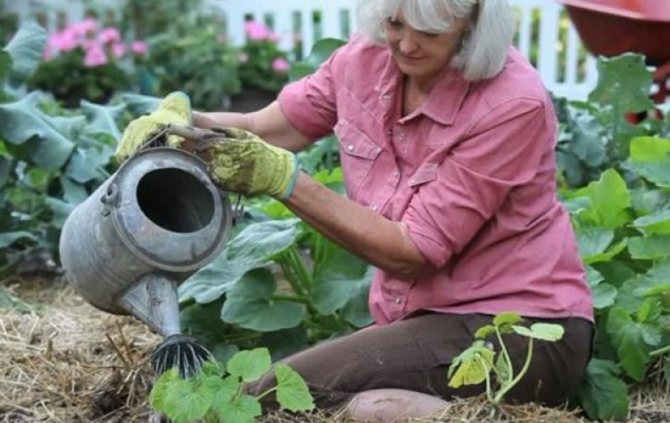

Top dressing
The plant needs about five fertilizers per season. They are carried out monthly with a frequency of two times. As a rule, they resort to the root method, watering the bushes with 1 kg of mullein and 250 g of wood ash dissolved in 10 liters of water.
Alternatively, you can use a 10: 1 infusion of green grass or chicken manure. A nitrogenous solution of two teaspoons of urea and a bucket of water is also suitable.
Pinching and shaping a bush
Luffa requires constant intervention in the process of its development. In order for the fruits to form evenly, it is recommended to remove the lateral processes and pinch the central shoot at a level of 4 m.
And also, starting from mid-June, you need to remove the excess ovary. Experts advise leaving 5-8 zelents so that the rest do not deplete the tops.


Garter to support
If the fruits are deformed and start to deteriorate on the vine, pay attention to the conditions for their growth. First, the growing lashes need to be regularly tied to the support. Secondly, it is important to spread the vine so that the ovary hangs freely from the trellis. Only then will the vegetables be large and even.
Tangerine potted care
The conditions for growing tangerines at home should be as close to natural as possible. Mandarin loves the sun, so the best place for it is a south-facing window, provided the indoor temperature does not drop below 14 ºC in winter. In summer, the plant can be kept on a balcony or loggia. However, in the afternoon, the tangerine should be protected from the sun's rays with a curtain made of light fabric or gauze.
A favorable temperature for the development, budding and flowering of tangerines is considered to be the interval from 16 to 18 ºC with an air humidity of 60%. However, do not worry if the room gets hot with the arrival of summer: tangerines can grow and bear fruit even at 40 ºC.
Watering the tangerine
Tangerine maintenance involves watering the plant regularly as the topsoil in the pot dries. There is a trick to help determine if a plant needs watering: take a pinch of soil from the pot with your fingers and squeeze it. If the soil sticks together, then water the tangerine early, and if it crumbles, then it's time to moisten the soil in the pot.
As for the humidity of the air, the tangerine, especially in the summer heat, needs to be sprinkled daily, and once a month it must be washed in a shower with soap, covering the stem of the plant and the soil in the pot with polyethylene. This hygiene procedure is also a pest prevention.
Mandarin fertilizer
During the dormant period, in winter, the tangerine does not need feeding, and during the growing season, a solution of complex mineral fertilizer is introduced into the soil twice a month. Adult plants with a height of 1 m or more to stimulate abundant fruiting are fed once a month with fish broth: 200 g of unsalted fish or fish waste is boiled in 2 liters of water for half an hour, allowed to cool and filtered through cheesecloth. The soil is watered with "fish soup" in the morning at an air temperature of 18-19 ºC.
Tangerine transplant
Young plants are transplanted annually, fruiting plants - once every 2-3 years, each time increasing the size of the pot in diameter by 4-6 cm.The soil for young animals should be of the following composition: sod land - 2 parts, and leafy soil, sand and humus - one piece at a time. For plants older than three years of turf land, you need to take three parts, and the rest of the ingredients - one at a time.
Tangerine pruning
Mandarin is one of those plants, the crown of which needs to be formed. If, with a growth of 30-40 cm, the seedling did not branch out by itself, it must be pinched to stimulate the formation of lateral shoots of the first order. However, this is not enough, since fruiting is carried out only on branches of the fourth to fifth order.
Sometimes, in order to enhance the branching of the shoots, they resort to deflecting and fixing them: one end of the soft wire is fixed on the branch, and the other - at the edge of the pot so that the wire pulls the top of the shoot down.
Harvesting
Young vegetables for cooking are removed from the vine, without waiting for their maturity. Then the fibers in the fruit are soft and tasty. If you miss the cleaning time, you will never taste the louffa dishes. Experienced housewives make frozen preparations for the winter from zelents.
If you are planning to make scouring pads, only remove ripe vegetables. They have a coarse, very hard brown skin. Over time, it dries and peels off easily, leaving dried fibers. You can dip the vegetables in boiling water for 20 minutes to speed up the bark cutting. The inside is washed in very warm water and dried.
Such a washcloth will serve you no more than 6 months. Ripe vegetables are also needed to harvest seed. They are harvested in October. A sign of ripe seeds is a specific ringing inside.
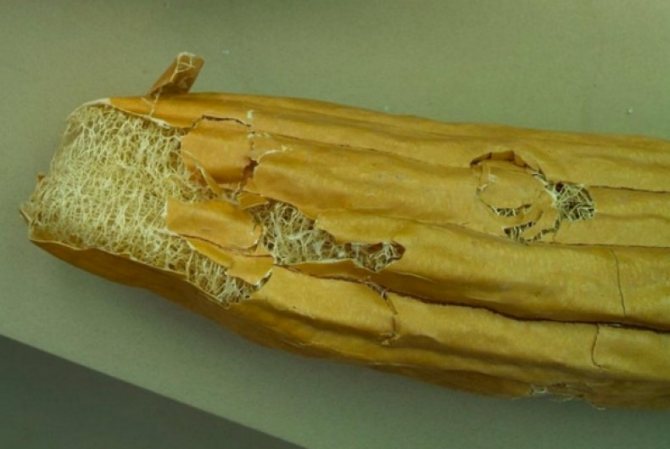

Types of luffa
Scientists distinguish only about fifty varieties of luffa, but of this variety, only the sharp-ribbed and cylindrical ones have been introduced into the culture, since the rest of the species are too small-fruited.
Luffa sharp-ribbed (Luffa acutangula) is a herbaceous vine with relatively small fruits up to 35 cm long. The vegetables stand out in a conical shape with clear ribs and a firm skin. It is almost impossible to tear it off. The species is cultivated mainly for culinary purposes, and only young green plants get into the kitchen.


The peculiarity of these vines is that they bloom only at night, respectively, and are pollinated by night moths. Agronomists note that the species is very unpretentious, easily adapts to any soil and is very resistant to pathogenic fungi.
Luffa cylindrical cultivated mainly for the preparation of washcloths. In everyday life, it is called "spongy". The variety has large fruits up to 70 cm long with delicate milky flesh and a thin skin that peels off easily.


Application and benefits
We can talk about the benefits of luffa for a very long time, since today scientists do not know anything about the harmful qualities of the plant.
But it has already been proven that natural sponges made from the fibers of ripe vegetables stimulate blood circulation, do not cause allergic reactions and skin irritations, have a lymphatic drainage effect and help solve the problems of cellulite and stretch marks.
The second say that the potential of the plant in society is still underestimated. From the fibers of the fruit, you can prepare unique vases, shades, pots, screens and even some pieces of furniture.
For people who know a lot about decor, Luffa is a real creation of Mother Nature. She, like a vine, in the skillful hands of craftsmen can turn into a very unexpected, but unsurpassed object.
Doctors talk about the healing properties of culture. Its juice can be used to treat conjunctivitis, problem skin, anemia, diseases of the nasopharynx and lungs. Antipyretic, tonic and immunostimulating effects of luffa are also noted.
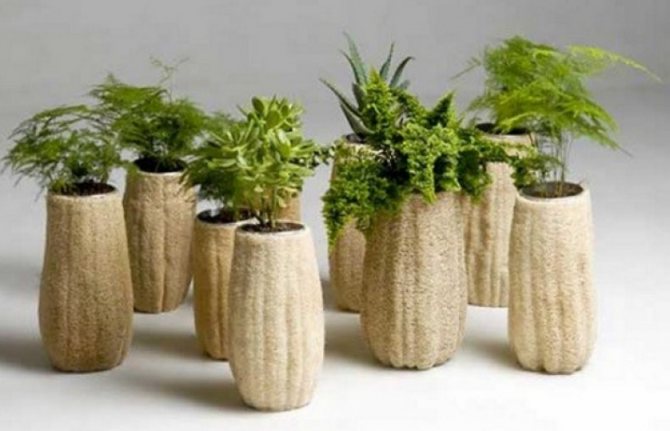

Pharmacists also talk about the benefits of the plant. On sale you can find many preparations based on the extract and oils of this exotic.
Obviously, there will be more talk about Luffa. In the meantime, let's not underestimate what nature has given us for beauty, spiritual and physical enjoyment. By following all the above recommendations, you will get a decent harvest of an exotic crop and make sure of its uniqueness.
Loofah is a growing sponge. Cultivation, application
Good afternoon, dear friends and guests of the site "I am a Selyanochka"! Let's talk today about an interesting loofah plant and about its application in our life with you. My interest in this plant arose not long ago, and this was due to the choice of a high-quality and environmentally friendly washcloth.
By the way, the word loofah should be written with two f, but people say and write with one, let it be in the folk way.
After reviewing a bunch of different washcloths in the store, I opted for a loofah washcloth.
The seller turned out to be very sociable, and we talked for a long time about the types and forms of washcloths, came to the conclusion that loofah, a natural product and a washcloth made from it are also natural and bring benefits and cleanliness to our body.
Loofah is a useful plant
The loofah plant is a genus of herbaceous vines, of the pumpkin family. Naturally grows in the regions of Asia and Africa. Is it possible to grow this plant here in Russia? Of course you can, it grows very well in the southern regions, by sowing seeds in the ground. In our Volga-Vyatka region and central Russia, loofah is grown using seedlings. But more on that later.
Loofah, an annual, beautiful and branched plant - liana. Shoots reach a length of 5 meters. The fruit grows up to 70 cm long. It can decorate and shade the gazebo, form a beautiful hedge, while you will get washcloths from its fruits and wonderful cosmetics from stems and leaves. Young, unripe fruits are eaten, and folk medicinal products are prepared from them.
Eating unripe fruits helps to strengthen the immune system and helps fight flatulence and bloating, treating chest cough, and increasing lactation in nursing mothers.
The healing properties of loofah
From a medical point of view, loofah will be useful not only for people, but also for animals, due to which it can be successfully used by veterinarians. However, in this direction, it is used little, while it serves human health much more. In particular, the fruits, leaves and ovaries of the plant are used in the following cases:
- with anemia and anemia (infusions and decoctions from young ovaries are used);
- with constipation and kidney problems (fresh fruits that have a laxative and diuretic effect on the body are perfect for creating medicines);
- in the treatment of jaundice (plant juice obtained from bitter loofah through tissue will be appropriate);
- with sexually transmitted diseases (it is useful to prepare infusions based on the fruits and seeds of the plant);
- with diseases of a dermatological nature (seed oil is especially useful);
- for cosmetic problems and children's conjunctivitis (with juice diluted in water, they wipe the affected areas and wash the eyes, and special masks are prepared to improve the appearance of the skin);
- at elevated temperatures, as an antipyretic agent;
- to accelerate the healing of ulcers and mechanical damage to the skin.
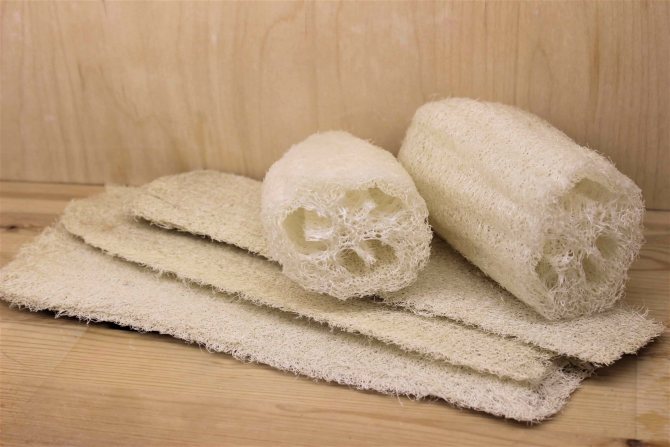

A loofah is a washcloth-like sponge made from the pulp of a special type of pumpkin.
Loofah is a natural, environmentally friendly product. The use of loofah effectively affects the human body, has a massage effect, activates the process of cellular renewal of the skin, and enhances microcirculation.
With regular massage (with or without soap), the skin becomes firm and silky. Loofah can be successfully used for anti-cellulite massage. It is very well accepted by the skin, moisturizes it, and improves elasticity.
Making loofah loofahs
The very first advantage of this plant is that good washcloths, natural and strong, are obtained from its ripe fruits. Medicine recommends the use of such washcloths. Using this washcloth, you will well cleanse the skin of old dead skin cells, it works as a good scrub, get an excellent muscle massage and clean, ruddy skin, reduce the appearance of "orange peel".
The fruits of the loofah ripen late, in our area it will be in October, we remove the fruits before frost and put them in a well-ventilated warm room to dry.
This process takes several days and sometimes weeks. You can check if the fruit is dry or not dry, take it and shake it, if the seeds roll inside and rustle, the fruit is ready for making a washcloth.
We soak the dried fruit of the loofah for several hours, it is advised to boil the water and let the fruits go there, boil for 10 minutes, so they will be easier to clean from the skin.
Another tip, if you want to have a hard washcloth, wait until the fruit ripens, and if you need a tender and soft washcloth, remove the unripe fruit and put it to dry.
We clean the dried fruits from the skin, remove the remaining pulp and seeds, use an iron brush for this. Cut off the fruit on both sides.
Wash in soapy water several times and dry. The eco-friendly sponge is ready!
And now you can dream up. The workpiece can be cut to any size, tie handles, model a massage mitt, make slippers, you can even think of different crafts. Here is such an amazing loofah fruit you can grow and make your own washcloths.
How to properly use a loofah washcloth
Before you use it, soak it in hot water for 2-3 minutes, you can rub.
Despite the naturalness and excellent effect, it is advised not to use a loofah loofah more than 2 times a week, especially for those with sensitive skin.Everything is good in moderation, use body cream after using a loofah loofah.
After use, wash and dry the washcloth well.
Loofah is a source of income
Making loofah scouring pads is a good job, you can grow several bushes - lianas, harvest and make a lot of natural scouring pads. Agree with shops and sell. With 20 loofah bushes, with good care and proper placement, up to 800 washcloths of different sizes can be prepared.
Loofah scouring pads are expensive, the profit will be tangible. As you gain experience, you can expand your washcloth production and supply the entire area with them. This is a good cash addition to your budget.
Loofah for skin care
Moisturizing mask
This wonderful mask is suitable for all our skin, for face and hands, heels and décolleté. Grind the loofah leaves and add a little honey, a few drops of olive oil and apply on the skin for 10 minutes. Wash off with warm water, apply a nourishing cream.
Lotion
We squeeze out the juice from young stems and leaves of the loofah and wipe it over the face and hands. It acts as a mild bleaching agent.
Use loofah sponges and sponges, these are great for removing makeup. Apply a cleanser to a dampened sponge and wipe your face in a circular motion, then rinse off with warm water.
This cleansing improves blood circulation and removes old cells, which helps to even out skin color. When caring for the skin of the body, it is highly recommended to use a loofah sponge.
Loofah is used in making handmade soap, this plant is very popular with soap-makers. Soap made on the basis of loofah has an exfoliating effect, which is very beneficial for our skin.
We suggest that you familiarize yourself with: Log size for a wooden floor
Today we got acquainted with an amazing and useful loofah plant, try to plant it on your site and grow your washcloths.
The site "I am a Selyanochka" wishes you good health and good mood!
Loofah - how to grow a natural loofah
- We buy loofah seeds, there are a great many varieties of it, the "Cylindrical" variety is recommended, it is well suited for making washcloths.
- The technology for growing loofah is similar to growing cucumbers. She does not like transplants, is hygrophilous, with a thickened planting, it bears bad fruit.
- We sow seeds in separate peat cups, from early March to mid-April, planting dates depend on your climate. In the Kirov region, we plant loofah seeds in early April.
- Make sure that the ground is always moist and the temperature before germination is high 25-30 degrees. When shoots appear, move the cups to a cooler place.
- Seedlings that have reached 40 days begin to harden. When the weather is warm, warm nights, they are planted in the ground from the south side.
- Loofah is very sensitive to soil, loves and bears fruit well on loose, light and nutritious soil. Prepare a site for it in the fall, add humus and ash.
- We prepare the hole, fill it with humus and mix it with the ground, transplant the seedlings carefully, without destroying the lump of earth where the roots are. The root system of the loofah is superficial, it is recommended to immediately put a support for the plants, and as it grows, pull the nets or guide the plant along a gazebo, a special arch.
- The distance between plants should be at least 1.5 meters, it grows very much, and with a thickened planting, it does not give a good harvest. When reaching 5 meters, the middle branch must be pinched, this will increase the yield.
- We feed the plant 1-2 times a month, put 1 liter of mullein and 0.5 liters of ash on a bucket of water.
- We do not let the earth dry out, but we also do not allow waterlogging.
This is how this wonderful and beautiful loofah plant can be grown.
Cylindrical loofah (Luffa cylindrica)
The cylindrical loofah is practically the same liana-like plant as the previous variety, but its length is somewhat longer.The yellow flowers are just as large, and the unripe young "cucumbers" are an ideal ingredient for many dishes.
In length, they reach 60-70 cm, which is almost twice as long as that of the sharp-ribbed variety. As soon as the peel on the fruit turns yellow, they can be removed and started to peel, extracting the fibrous pulp itself.
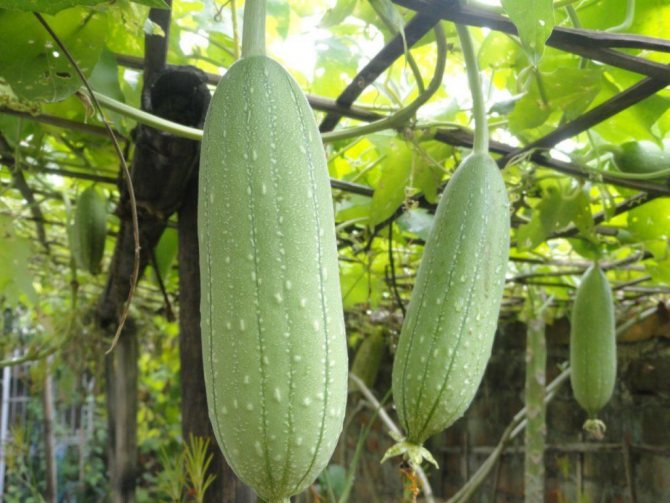

Cylindrical loofah (Luffa cylindrica).
The cylindrical variety of "mad cucumber" is more suitable for making washcloths, although they do not disdain the plant in cooking: in addition to the fruits themselves, they use leaves rich in carotene (its content is almost 1.5 times higher than that of such popular vegetables as carrots and sweet bell pepper).

